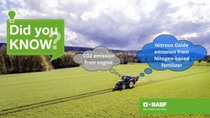Agriculture
Did you know Nitrous Oxide gas is 265 times more greenhouse warming than CO2?

Nitrogen is essential for all living organisms. Its availability is one of the key factors determining agricultural productivity. Although nitrogen is present in large quantities in the air, it is not sufficiently available to crops. Farmers use fertilizers to make nitrogen available for their crops. However, nitrogen use efficiency is low as only about half the nitrogen applied through fertilizers is absorbed by crops. The rest remains in soil, leaches into ground and surface waters or is lost to the atmosphere as ammonia and/or nitrous oxide gas.
In its Farm to Fork Strategy the EU Commission announced that it will act to reduce nutrient losses by at least 50% and the use of fertilizers by at least 20% by 2030. Innovative solutions have been developed which help reduce nitrogen losses. These include using nitrification inhibitors to reduce, for a certain period, the conversion of ammonium into nitrate and thus reduce the formation of the powerful greenhouse gas: nitrous oxide. Ideally this technology should be combined with precision agriculture techniques to ensure that only exact amounts of fertilizers required by crops are applied to each part of the field. Scientific studies [1] have demonstrated that use of nitrification inhibitors can reduce nitrous oxide emissions from agricultural systems by 44% and nitrate leaching by 47%.

To know more about the nitrogen use efficiency, find below a short video.
[1] Qiao, Chunlian & Liu, Lingli & Hu, Shuijin & Compoton, Jana & Greaver, Tara & Li, Quanlin. (2014).
How inhibiting nitrification affects nitrogen cycle and reduces environmental impacts of anthropogenic nitrogen input. Global change biology. 21. 10.1111/gcb.12802.